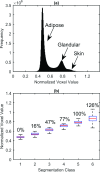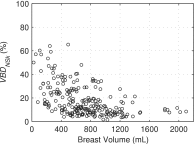Population of 224 realistic human subject-based computational breast phantoms
- PMID: 26745896
- PMCID: PMC4684566
- DOI: 10.1118/1.4937597
Population of 224 realistic human subject-based computational breast phantoms
Abstract
Purpose: To create a database of highly realistic and anatomically variable 3D virtual breast phantoms based on dedicated breast computed tomography (bCT) data.
Methods: A tissue classification and segmentation algorithm was used to create realistic and detailed 3D computational breast phantoms based on 230 + dedicated bCT datasets from normal human subjects. The breast volume was identified using a coarse three-class fuzzy C-means segmentation algorithm which accounted for and removed motion blur at the breast periphery. Noise in the bCT data was reduced through application of a postreconstruction 3D bilateral filter. A 3D adipose nonuniformity (bias field) correction was then applied followed by glandular segmentation using a 3D bias-corrected fuzzy C-means algorithm. Multiple tissue classes were defined including skin, adipose, and several fractional glandular densities. Following segmentation, a skin mask was produced which preserved the interdigitated skin, adipose, and glandular boundaries of the skin interior. Finally, surface modeling was used to produce digital phantoms with methods complementary to the XCAT suite of digital human phantoms.
Results: After rejecting some datasets due to artifacts, 224 virtual breast phantoms were created which emulate the complex breast parenchyma of actual human subjects. The volume breast density (with skin) ranged from 5.5% to 66.3% with a mean value of 25.3% ± 13.2%. Breast volumes ranged from 25.0 to 2099.6 ml with a mean value of 716.3 ± 386.5 ml. Three breast phantoms were selected for imaging with digital compression (using finite element modeling) and simple ray-tracing, and the results show promise in their potential to produce realistic simulated mammograms.
Conclusions: This work provides a new population of 224 breast phantoms based on in vivo bCT data for imaging research. Compared to previous studies based on only a few prototype cases, this dataset provides a rich source of new cases spanning a wide range of breast types, volumes, densities, and parenchymal patterns.
Figures







Similar articles
-
Generation of a suite of 3D computer-generated breast phantoms from a limited set of human subject data.Med Phys. 2013 Apr;40(4):043703. doi: 10.1118/1.4794924. Med Phys. 2013. PMID: 23556929 Free PMC article.
-
Dataset of patient-derived digital breast phantoms for in silico studies in breast computed tomography, digital breast tomosynthesis, and digital mammography.Med Phys. 2021 May;48(5):2682-2693. doi: 10.1002/mp.14826. Epub 2021 Apr 3. Med Phys. 2021. PMID: 33683711
-
Updated breast CT dose coefficients (DgNCT ) using patient-derived breast shapes and heterogeneous fibroglandular distributions.Med Phys. 2019 Mar;46(3):1455-1466. doi: 10.1002/mp.13391. Epub 2019 Feb 8. Med Phys. 2019. PMID: 30661250
-
Advances in digital and physical anthropomorphic breast phantoms for x-ray imaging.Med Phys. 2018 Oct;45(10):e870-e885. doi: 10.1002/mp.13110. Epub 2018 Aug 28. Med Phys. 2018. PMID: 30058117 Review.
-
The advent of anthropomorphic three-dimensional breast phantoms for X-ray imaging.Phys Med. 2020 Nov;79:145-161. doi: 10.1016/j.ejmp.2020.11.025. Epub 2020 Dec 13. Phys Med. 2020. PMID: 33321469 Review.
Cited by
-
Three-dimensionally-printed anthropomorphic physical phantom for mammography and digital breast tomosynthesis with custom materials, lesions, and uniform quality control region.J Med Imaging (Bellingham). 2019 Apr;6(2):021604. doi: 10.1117/1.JMI.6.2.021604. Epub 2019 Mar 22. J Med Imaging (Bellingham). 2019. PMID: 30915385 Free PMC article.
-
Impact of breast structure on lesion detection in breast tomosynthesis, a simulation study.J Med Imaging (Bellingham). 2016 Jul;3(3):035504. doi: 10.1117/1.JMI.3.3.035504. Epub 2016 Sep 13. J Med Imaging (Bellingham). 2016. PMID: 27660807 Free PMC article.
-
Toward 7T breast MRI clinical study: safety assessment using simulation of heterogeneous breast models in RF exposure.Magn Reson Med. 2019 Feb;81(2):1307-1321. doi: 10.1002/mrm.27395. Epub 2018 Sep 14. Magn Reson Med. 2019. PMID: 30216530 Free PMC article.
-
Virtual assessment of stereoscopic viewing of digital breast tomosynthesis projection images.J Med Imaging (Bellingham). 2018 Jan;5(1):015501. doi: 10.1117/1.JMI.5.1.015501. Epub 2018 Jan 17. J Med Imaging (Bellingham). 2018. PMID: 29376103 Free PMC article.
-
An Anthropomorphic Digital Reference Object (DRO) for Simulation and Analysis of Breast DCE MRI Techniques.Tomography. 2022 Apr 2;8(2):1005-1023. doi: 10.3390/tomography8020081. Tomography. 2022. PMID: 35448715 Free PMC article.
References
-
- Kerlikowske K., Carney P. A., Geller B., Mandelson M. T., Taplin S. H., Malvin K., Ernster V., Urban N., Cutter G., Rosenberg R., and Ballard-Barbash R., “Performance of screening mammography among women with and without a first-degree relative with breast cancer,” Ann. Intern. Med. 133, 855–863 (2000).10.7326/0003-4819-133-11-200012050-00009 - DOI - PubMed
Publication types
MeSH terms
Grants and funding
LinkOut - more resources
Full Text Sources
Other Literature Sources
Medical

